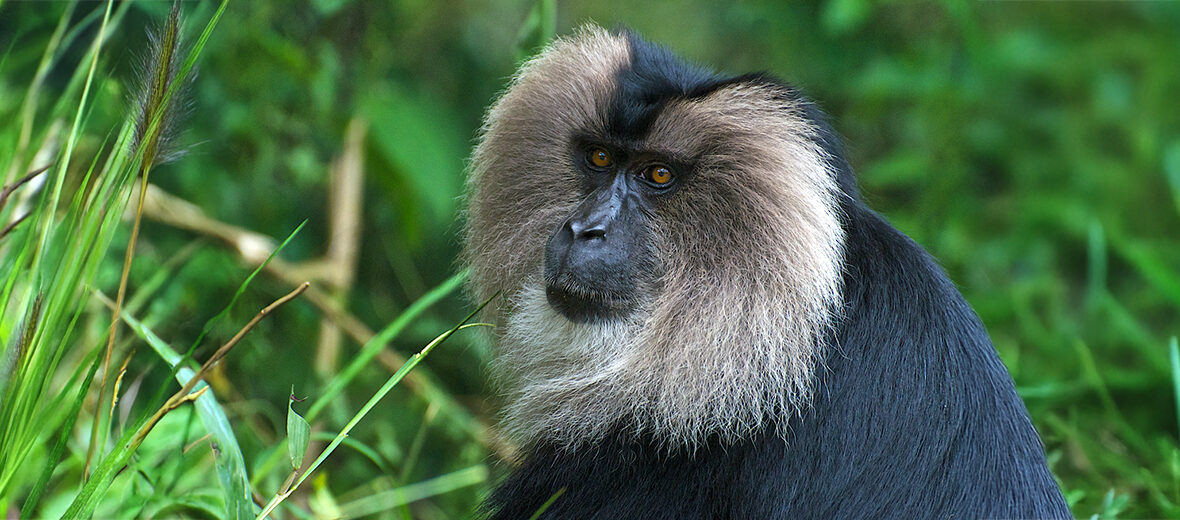
The lion-tailed macaque, aka wanderoo, is a primate that hails from Karnataka, Kerala, and Tamil Nadu in India. These monkeys face the threats of habitat loss and destruction at the hands of farming and logging; hunting; trapping; and ecosystem modifications. They numbered only a mere 2,500 individuals as of 2015, and their populations have been decreasing, so that number is likely far less. The IUCN lists these creatures as Endangered.
First the Stats…
Scientific name: Macaca silenus
Weight: Up to 22 lbs.
Length: Up to 24 inches, plus up to a 9.8 inch tail
Lifespan: Up to 30 years
Now on to the Facts!
1.) Like other macaques, they have deep cheek pouches used for storing food.
2.) They are are quadrupedal (walk on all fours) and have opposable thumbs.
3.) These macaques prefer the upper canopy of tropical moist evergreen forests or monsoon forests.
4.) Lion-tailed macaques are diurnal (active during the day).
5.) Their days are divided up as 50% foraging and 50% resting or looking for new areas to forage.
But wait, there’s more on the lion-tailed macaque!
6.) Much like other macaque species, these primates dwell in hierarchical groups of up to 20 individuals.
7.) Like other primates, they are polygynous (1 male mates with multiple females).
Did you know…?
Due to their large mane, they are given the German name Bartaffe, which translates to “beard ape”.
8.) Unlike other primate species, very little time is spent grooming one another or playing with each other.
9.) If their loud cries and bared teeth don’t thwart invading troops, they will brawl aggressively, which usually results in severe injuries due to lacerations from their large, sharp canine teeth.
10.) Other types of communication take the forms of branch shaking to scare off intruders, mounting to show strength, lip-smacking as a friendly greeting, and/or yawning with a grimace to indicate dominance.
But wait, there’s still more on the lion-tailed macaque!
11.) These macaques are arboreal (spend most of their time in trees).
12.) Indigenous fruits, flowers, seeds, insects, snails, mice, juvenile rats, lizards, and frogs are all on the menu.
Did you know…?
Unfortunately, due to massive logging efforts, there has been a large increase in ground foraging and feeding on much more non-native plants and insects. They have even been observed preying on nestlings and eggs of pigeons.
13.) While there is no designated mating season, these primates tend to mate more during the wet season, when food is more readily available.
14.) Females undergo up to a 6 month gestation (pregnancy) that yields a single infant.
15.) Weaning is completed in up to 1 year.
But wait, there’s still a tad more on the lion-tailed macaque!
16.) Snakes, raptors, and tigers all prey on these primates.
17.) Due to their low reproduction numbers and high levels of habitat fragmentation, they are also very susceptible to inbreeding, which can cause a variety of genetic issues, such as infertility and immunocompromised infants.
18.) The lion-tailed macaque currently ranks among the rarest and most threatened primates.
Now a Short Lion-Tailed Macaque Video!
Be sure to share & comment below! Also, check out the Critter Science YouTube channel. Videos added regularly!
Want to suggest a critter for me to write about? Let me know here.
Some source material acquired from: Wikipedia & IUCN
Photo credit: Dharani Prakash




